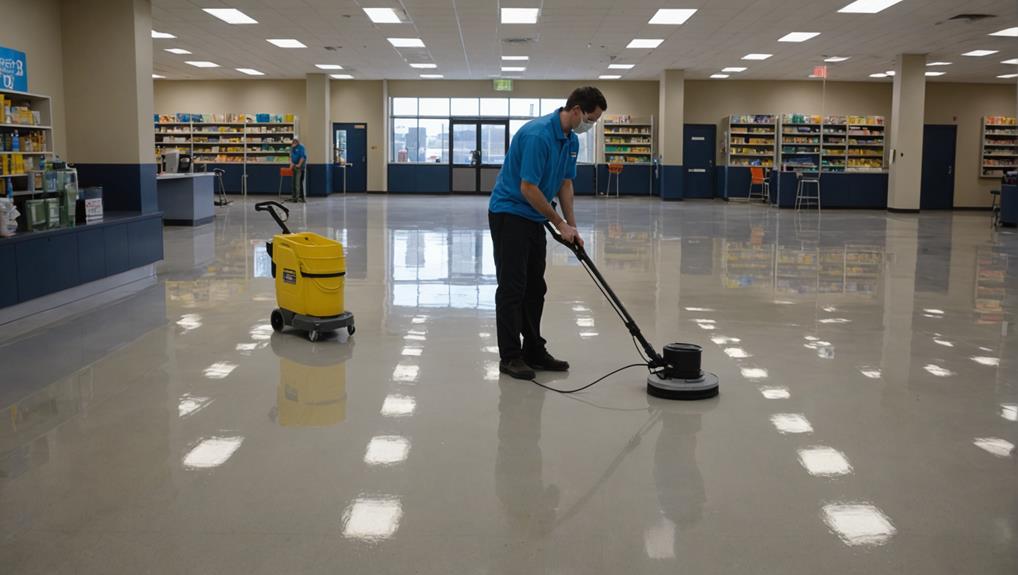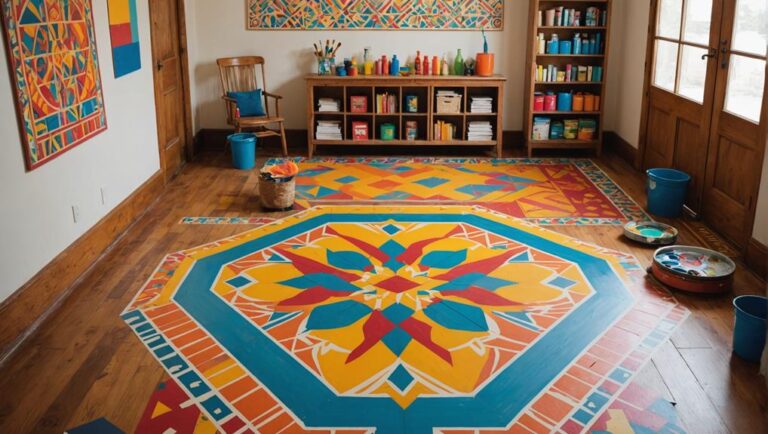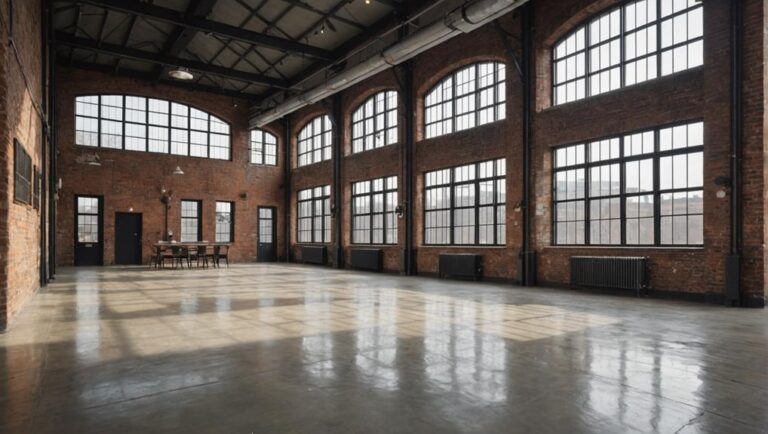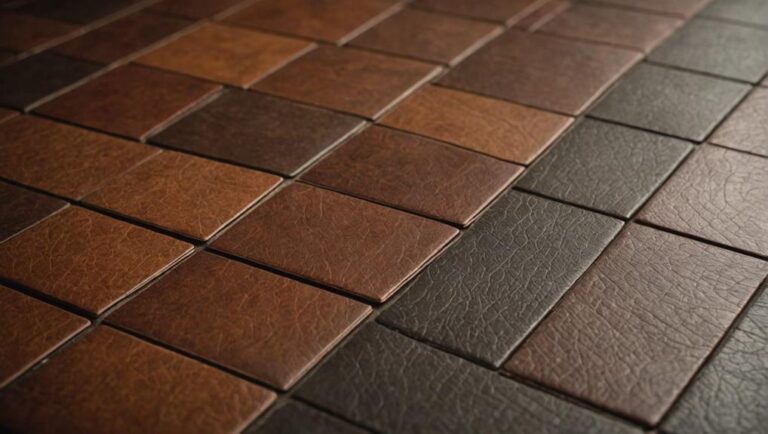To clean and maintain commercial floors, start with a daily routine tailored to your flooring type. For high-traffic areas, remove debris using a broom or vacuum, and mop with pH-neutral cleaners. Weekly, deep clean using specialized equipment like floor scrubbers and commercial vacuums. Monthly, inspect for wear and tear, and assess cleaning solutions for effectiveness. Utilize eco-friendly products that suit your floor's material to prevent damage. Don't forget seasonal maintenance to address unique challenges throughout the year. Following these practices will enhance safety and longevity, and there's much more to learn about optimizing your cleaning strategies.
Importance of Floor Maintenance
When it comes to maintaining a commercial space, the importance of floor maintenance can't be overstated. Proper care of your floors directly impacts their longevity, which in turn affects the overall aesthetics and safety of your environment. Regular maintenance guarantees that floors remain in peak condition, preventing premature deterioration caused by wear and tear, spills, and foot traffic.
To uphold hygiene standards, you must implement a consistent cleaning regimen. Accumulated dirt, dust, and grime not only detract from the appearance of your floors but can also pose health risks. Regularly scheduled cleaning sessions help eliminate allergens and bacteria, guaranteeing a safe space for both employees and clients. It's crucial to choose the right cleaning products that are compatible with your flooring type to avoid damage while effectively maintaining cleanliness.
Moreover, adequate floor maintenance can help prevent accidents related to slips and falls. By addressing spills promptly and guaranteeing proper cleaning techniques are employed, you can create a safer workspace. Keeping floors in good condition also enhances their durability, reducing the need for costly repairs or replacements in the future.
Types of Commercial Flooring
Selecting the right type of flooring is a pivotal aspect of maintaining a commercial space effectively. Your choice can impact safety, cleanliness, and overall aesthetics. Among the most popular options is vinyl flooring, known for its durability and ease of maintenance, making it ideal for high-traffic areas.
Tile options, including ceramic and porcelain, provide excellent resistance to spills and stains, offering both functional and stylish solutions. For comfort and warmth, consider various carpet types; they can reduce noise and enhance safety by providing traction.
If you're looking for a classic appeal, hardwood choices can elevate your space's ambience, though they may require more maintenance to prevent damage from moisture. Laminate surfaces offer a budget-friendly alternative to hardwood, providing a similar look with added resistance to scratches and wear.
Concrete finishes are increasingly popular for their industrial aesthetic and durability. They can be customized with different textures and colors, and they are particularly effective in warehouses and large commercial areas. For those seeking a seamless and highly durable surface, epoxy coatings can offer a robust solution, resistant to chemicals and easy to clean.
Lastly, rubber flooring is an excellent choice for areas demanding slip resistance, such as gyms or healthcare facilities. It's comfortable underfoot and provides excellent cushioning, enhancing safety in spaces where slips and falls are a concern. By understanding these various flooring options, you can make informed decisions that align with your commercial space's needs.
Daily Cleaning Practices
Maintaining a clean commercial floor requires consistent daily cleaning practices to secure its longevity and appearance. By establishing a cleaning schedule tailored to your specific environment, you can effectively manage the impact of floor traffic on your surfaces. The goal is to minimize dirt and grime accumulation while guaranteeing a safe environment for employees and customers.
Start by evaluating the level of foot traffic in your facility. High-traffic areas need more frequent attention, whereas less frequented zones can be cleaned less often. A good rule of thumb is to develop a daily cleaning schedule that outlines which areas need to be cleaned and at what times. This helps maintain organization and guarantees no area is overlooked.
Begin your daily cleaning with the removal of loose debris using a broom or vacuum. This step is vital, as it prevents scratches and damage to your flooring. Next, utilize a damp mop with a pH-neutral cleaner suitable for your specific flooring type. Avoid using harsh chemicals that could compromise the integrity of your floors.
Weekly Deep Cleaning
When it comes to weekly deep cleaning, you'll need to gather essential equipment and select effective cleaning solutions to guarantee your floors are thoroughly maintained. Understanding the step-by-step process will help you achieve ideal results while minimizing damage to the surface. Let's explore these critical components to enhance your cleaning routine.
Essential Equipment Needed
To guarantee an effective weekly deep cleaning of commercial floors, having the right equipment on hand is fundamental. Start with a high-quality floor scrubber, which utilizes advanced floor cleaning technologies to remove dirt and grime efficiently. A commercial-grade vacuum cleaner is also important, especially for carpets and rugs, making sure you manage dust and allergens effectively, which contributes to overall commercial floor safety.
Next, invest in microfiber mops and cloths. They're not only effective at trapping dust but also minimize the risk of scratching surfaces. A reliable floor buffer can help maintain the shine on hard surfaces, prolonging their lifespan. Don't forget about safety gear; gloves and non-slip footwear are essential to protect your staff during the cleaning process.
For difficult-to-reach areas, consider a steam cleaner. It uses heat to disinfect and remove stubborn stains without harsh chemicals, promoting a safer environment. Finally, confirm you have an assortment of brushes and squeegees on hand to tackle specific cleaning challenges. By equipping yourself with these fundamental tools, you'll enhance both the efficiency and safety of your weekly deep cleaning routine.
Effective Cleaning Solutions
Choosing the right cleaning solutions is vital for effective weekly deep cleaning of commercial floors. When selecting products, consider both their cleaning power and safety profile. Eco-friendly solutions are increasingly popular, as they minimize environmental impact while guaranteeing a safe environment for your staff and clients. These biodegradable options effectively remove dirt and grime without harmful chemicals, making them suitable for various surfaces.
On the other hand, industrial cleaners are specifically formulated for tougher stains and heavy-duty cleaning needs. If your facility experiences high foot traffic or spills that require more robust treatment, these cleaners can be invaluable. However, it's important to follow safety guidelines and manufacturer instructions when using industrial products. Always wear appropriate personal protective equipment (PPE) and maintain proper ventilation during the cleaning process.
Before applying any cleaning solution, perform a patch test on a small, inconspicuous area of the floor. This step will help you avoid potential damage to your flooring. By thoughtfully selecting eco-friendly solutions or industrial cleaners based on your unique requirements, you can maintain not just the appearance but the longevity of your commercial floors, all while prioritizing safety.
Step-by-Step Process
After selecting the appropriate cleaning solutions, it's important to implement a systematic approach for weekly deep cleaning of your commercial floors. Start by ensuring safety; put up "Wet Floor" signs and remove any obstacles.
Next, gather your necessary tools: a vacuum or broom, mop, bucket, and the chosen cleaning solution. Begin with dry cleaning techniques—vacuum or sweep to eliminate dust and debris. This step is essential for effective floor care, as it prevents dirt from scratching the surface during mopping.
Once the dry debris is removed, prepare your cleaning solution according to the manufacturer's instructions. Dip your mop into the solution, wring it out to avoid excess moisture, and start mopping the floor in a systematic pattern, working from one end of the room to the other.
Pay special attention to corners and high-traffic areas, as these often accumulate grime. After mopping, allow the floors to air dry completely before allowing foot traffic. Finally, inspect your work, ensuring no spots were missed, and store your cleaning supplies properly for future use. Following these cleaning techniques consistently will maintain the longevity and appearance of your commercial floors.
Monthly Maintenance Tasks
Maintaining commercial floors requires consistent attention, and monthly maintenance tasks play a crucial role in preserving their appearance and longevity. By dedicating time each month to specific inspections and routine checks, you can identify potential issues before they escalate, guaranteeing both safety and aesthetics.
Start your monthly inspections by checking for wear and tear, particularly in high-traffic areas. Look for scratches, scuff marks, or any signs of damage that could compromise safety. Pay special attention to corners and edges where dirt and debris tend to accumulate, as these can lead to more significant issues if left unattended.
Next, conduct routine checks on your flooring's cleaning regimen. Evaluate the effectiveness of your cleaning solutions and equipment. Are they suitable for your floor type? Confirm that your floor maintenance products are compliant with safety standards to prevent slips and falls.
It's also essential to assess your floor's finish. If the shine appears dull or uneven, consider scheduling a refinishing process to restore its original luster. Additionally, check for any moisture or spills that could lead to mold growth or surface damage.
Stain Removal Techniques
When it comes to maintaining commercial floors, understanding common stain types is essential for effective cleaning. You'll need to identify the specific stains you're dealing with to choose the most suitable cleaning solutions. By applying the right techniques, you can guarantee your floors remain clean and presentable for clients and employees alike.
Common Stain Types
Dealing with common stains on commercial floors can be frustrating, but understanding the types of stains and how to tackle them makes the process much easier. Proper stain identification is essential for effective stain prevention and ensuring your floors remain in top condition.
Here's a quick reference table for common stain types and their characteristics:
| Stain Type | Characteristics |
|---|---|
| Oil | Dark, greasy spots often from food or machinery. |
| Water | Generally clear, but may create discoloration over time. |
| Ink | Deep, dark marks that can spread if not treated quickly. |
| Food & Beverage | Varying colors and textures, often sticky or greasy. |
| Chemical | May leave a residue or discoloration, depending on the substance. |
Recognizing these stains allows you to act swiftly. For example, oil stains require immediate attention to prevent them from setting, while water stains may need to be dried thoroughly. By being proactive in stain identification, you can implement stain prevention strategies to maintain your commercial floors effectively. Remember, addressing stains promptly not only improves appearance but also prolongs the life of your flooring.
Effective Cleaning Solutions
Identifying the type of stain is just the first step in keeping your commercial floors looking their best. Once you know the stain, you can choose the right cleaning solution. For many common stains like coffee or grease, you'll want to opt for eco-friendly solutions that not only clean effectively but also guarantee safety for your employees and clients.
Start by mixing a few drops of mild dish soap with warm water. This cost-effective cleaner can tackle most everyday spills without leaving toxic residues. For tougher stains, consider using a vinegar-water solution, which works well on hard surfaces and is both safe and eco-friendly.
When dealing with ink or paint, apply rubbing alcohol on a cloth and blot the stain—never scrub, as this might spread the ink. If you're confronted with stubborn stains, you might need specialized eco-friendly solutions designed for commercial use. Always test any cleaner on a small, inconspicuous area first to verify it won't damage your flooring.
Best Cleaning Products
In the quest for pristine commercial floors, choosing the right cleaning products is crucial. You'll want to prioritize options that not only clean effectively but also maintain the integrity of your flooring materials. Start by evaluating the surface compatibility of your floors. Different materials, such as tile, vinyl, or hardwood, require specific cleaning solutions to avoid damage.
When selecting cleaning products, consider eco-friendly options. These products are not only safer for the environment but also pose fewer health risks for your employees and customers. Look for biodegradable detergents and non-toxic disinfectants that meet safety standards. Always check for certifications, such as Green Seal or EcoLogo, which can guide you in making safer choices.
Additionally, pay attention to the pH level of the cleaning solutions you choose. Products with a neutral pH are often safest for various surfaces, while acidic or alkaline cleaners can damage certain materials over time. You should also verify that the cleaning agents are effective against the specific types of dirt and grime found in your commercial environment, such as grease or stains.
Lastly, it's wise to conduct a spot test on a small, inconspicuous area before applying any new cleaning product to the entire floor. This precaution helps you confirm surface compatibility and prevent any potential damage. By carefully selecting the right cleaning products, you'll not only achieve a clean appearance but also extend the lifespan of your commercial floors.
Equipment for Floor Care
When it comes to maintaining commercial floors, having the right equipment is vital for achieving the best results. You'll want to familiarize yourself with essential cleaning tools, as well as an overview of maintenance equipment that guarantees longevity and efficiency. By selecting the appropriate gear, you can streamline your cleaning process and enhance the overall appearance of your floors.
Essential Cleaning Tools
A well-equipped cleaning arsenal is essential for maintaining commercial floors effectively. You'll need a variety of tools tailored to different cleaning techniques and materials. Start with a high-quality vacuum designed for commercial use; it'll remove dirt and debris without damaging the surface. For hard floors, a mop system with microfiber pads is invaluable, as it can efficiently pick up dust and grime while minimizing water usage.
Don't forget a floor scrubber, particularly for larger areas. These machines can save time and guarantee a thorough clean, fitting seamlessly into your maintenance schedules. For those hard-to-reach spots, a detailing brush or scraper can be handy to maintain cleanliness and safety.
Safety should always be your priority. When selecting cleaning tools, choose those that are ergonomic and lightweight to reduce strain during use. Additionally, always have personal protective equipment (PPE) available, such as gloves and non-slip footwear, to keep you safe while you work.
Maintenance Equipment Overview
Choosing the right maintenance equipment is important for effective floor care in commercial settings. The tools you select directly impact your floor maintenance routine and overall equipment efficiency. A well-chosen floor scrubber can greatly reduce labor time while guaranteeing a thorough clean, making it a valuable investment for your operations.
You'll need to evaluate several types of equipment, including vacuum cleaners, floor buffers, and automatic scrubbers. Each piece plays a critical role in maintaining various surface types, from hardwood to tile. For instance, a vacuum with HEPA filtration improves air quality while effectively removing dirt and allergens.
Additionally, floor buffers can restore shine and prolong the life of your flooring materials, but it's essential to use them correctly to avoid damage. Regular maintenance of this equipment is also necessary; check belts, brushes, and filters to confirm they function efficiently.
Ultimately, investing in high-quality equipment tailored to your specific floor care needs not only enhances safety but also promotes a healthier environment. By prioritizing proper maintenance equipment, you'll achieve cleaner floors and improve the longevity of your investments.
Seasonal Maintenance Tips
Understanding the unique challenges each season brings is essential for maintaining the longevity and appearance of commercial floors. Each season requires a tailored approach to cleaning and maintenance to guarantee safety and aesthetics.
In spring, it's time for thorough spring cleaning. Begin by deep cleaning carpets and hard floors to remove any accumulated dirt and debris from winter. Utilize appropriate cleaning solutions that are safe for your specific floor type. Inspect for any wear and tear and address issues such as scratches or stains promptly. This proactive approach not only enhances visual appeal but also safeguards the surface integrity.
As summer approaches, focus on keeping floors cool and slip-resistant, especially in high-traffic areas. Regularly sweep and mop to minimize dust and grime accumulation. Consider implementing a matting system at entrances to trap dirt and moisture, reducing maintenance needs.
When fall arrives, prepare for the winter months ahead. Apply protective sealants to hard surfaces, which can help prevent damage from ice and salt during the colder months. Conduct a thorough inspection for any repairs needed to guarantee safety, as wet leaves and debris can create slip hazards.
In winter, take essential precautions. Regularly clear snow and ice from entrances and walkways to prevent accidents. Use floor mats to minimize moisture inside. Additionally, make certain that cleaning staff uses non-slip cleaning products to maintain traction.
When to Hire Professionals
While regular maintenance can often keep commercial floors in good condition, there are times when hiring professionals becomes necessary to guarantee excellent results. Understanding when to make that decision is vital for maintaining a safe and appealing environment for your business.
First, consider the level of foot traffic your floors endure. High-traffic areas may require professional intervention more frequently, as dirt and grime can accumulate faster than standard cleaning can address. If you notice persistent stains, scuff marks, or a dull appearance, it's time to consult experts who can restore your floors to their original condition.
Cost considerations also play a significant role in deciding when to hire professionals. While DIY options may seem economical, the long-term costs of potential damage from improper cleaning techniques can outweigh initial savings. Investing in professional cleaning services can prolong the life of your flooring and save you money in the long run.
Additionally, frequency guidelines for professional cleaning often suggest a schedule based on your specific flooring type and usage. For instance, carpets may need deep cleaning every 6-12 months, while hard surfaces might require periodic stripping and waxing. Consulting with a professional can help you establish a tailored maintenance schedule that aligns with your business needs.
Ultimately, prioritizing safety and aesthetics should guide your decision. If you're unsure, don't hesitate to seek advice from cleaning professionals to make certain your commercial floors remain in excellent condition.
Frequently Asked Questions
How Often Should Commercial Floors Be Stripped and Waxed?
Picture your floors as a well-tuned orchestra; they need regular attention to keep playing in harmony. For ideal floor maintenance frequency, it's recommended to strip and wax every 6 to 12 months, depending on foot traffic and usage. A well-planned stripping schedule not only enhances appearance but also protects the surface, ensuring safety by preventing slips and falls. Regular care keeps your floors looking pristine and extends their lifespan greatly.
Can I Use Household Cleaners on Commercial Floors?
You shouldn't use household cleaners on commercial floors. These cleaning products often contain harsh chemicals that can damage specific floor types, such as vinyl or hardwood. Instead, opt for commercial-grade cleaners designed for your floor's material. These products guarantee effective cleaning while maintaining safety and integrity. Always check manufacturer instructions for compatibility and follow guidelines for dilution and application to avoid any damage or safety hazards. Prioritizing the right products will prolong your flooring's lifespan.
Are There Eco-Friendly Cleaning Options for Commercial Floors?
Choosing eco-friendly cleaning options for commercial floors is like selecting a fine wine; the right choice enhances the experience. You can opt for natural cleaners made from plant-based ingredients that effectively clean without harsh chemicals. These products not only guarantee safety for employees and clients but also contribute to floor maintenance by being gentle yet effective. Regularly using these cleaners can prolong the life of your floors while promoting a healthier environment.
What Should I Do if My Floor Gets Scratched?
If your floor gets scratched, you should first assess the severity of the damage. For minor scratches, consider using a scratch repair kit specifically designed for your floor type. Apply it carefully and follow the manufacturer's instructions. For deeper scratches, you might need to sand the area lightly and refinish it. To prevent future scratches, invest in floor protection options, like mats or furniture pads, ensuring your floors maintain their appearance and safety.
How Can I Prevent Slips and Falls on My Commercial Floors?
To prevent slips and falls on your commercial floors, you need to implement effective floor safety measures. Start by using slip-resistant materials in high-traffic areas, which considerably reduce the risk of accidents. Regularly inspect and maintain these surfaces to guarantee they remain effective. Additionally, keep floors clean and dry, and consider using mats in entryways to trap moisture. Training your staff on safety practices further enhances the overall safety of your environment.




